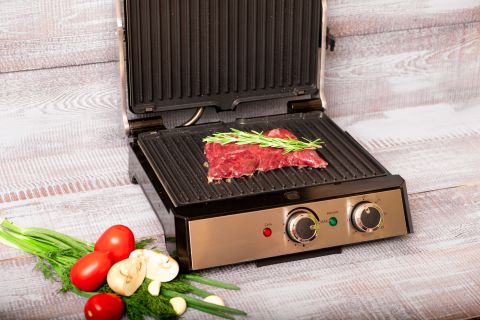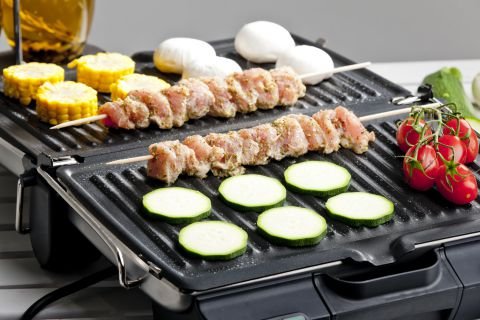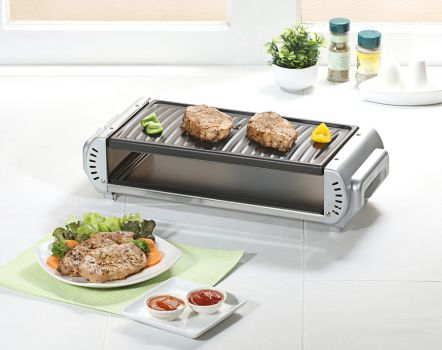In this article, we answer the question of how do smokeless grills work and other related questions. You will wonder why you never thought of getting one before!
A summer staple is a good barbecue party with your favorite proteins and vegetables on the grill. The traditional grill has been an essential part of a barbeque, however, the weather should be suitable, and you must have a backyard or a huge balcony to make space for it. In such a situation, a smokeless grill seems like a dream come true.
Sure, there are other indoor options, such as stovetop searing and using an oven to grill, but they come with cons like creating too much smoke, drying out your protein, and losing out on rich, charred flavor. In such a scenario, the electric grill is the best option, which is why food trucks use them for grilling in their enclosed space. If you want to lower the smoke generated, go one step further and opt for its smokeless variety where you can barbecue indoors without the smoke.
The most significant advantage of a smokeless grill is its convenience. You can grill indoors with minimal smoke and much quicker than a conventional grill. The easier cleaning also adds to its appeal.
Table of Contents
Do Smokeless Indoor Grills Work and Are They Really Smokeless?
The short answer to the first question is yes; smokeless grills do work. They use infrared heating to grill your food, and any fat accumulated drips down to the drip tray, which is cold, so the smoke generated is relatively low. When it comes to the question of whether they are entirely smokeless, the answer is technically no. But wait! The smokeless grill produces significantly less smoke than other indoor grill options, and even so, the minimal smoke it does create is not enough to set off your smoke alarms, so it is still a great option for your indoor grilling needs. Most Korean barbecue grills are also smokeless, which is why this type of meal is prepared indoors.
How Does a Smokeless Grill Work?
Now that you know the ‘what’, you may want to know the ‘how’. Smokeless grills are called so because their features aim to grill your food while simultaneously minimizing the smoke generated. The most common features that allow this type of grill to do so are infrared technology, smoke extractors, and drip trays. The combination of these features differs from model to model, so keep in mind the features you would ideally like to have while making your decision while choosing the best indoor smokeless grill for your needs.
The infrared technology evenly heats your ingredients through heat reflectors and produces less heat overall than regular grills.
The smoke extraction technology uses a turbo speed fan underneath to suck and absorb smoke and odor and provide the necessary cooling.
Drip trays holding some water in smokeless grills play the role of collecting any fat, grease, or essentially anything that may drip down (hence the name) during the grilling process. This prevents it from dripping directly onto the heat source, which would result in smoke. The water immediately neutralizes the hot fat too. In a regular grill, this would be one of the biggest causes of smoke, so the drip tray helps the smokeless grill stay, for the most part, smokeless. Another bonus is that the drip tray and the non-stick grill surface make cleaning up a much easier process since there are few stubborn grease stains.
The grill surface coating also reduces the need for much oil or other types of fat for cooking, which would create more smoke.
Coming to the lid of a grill, not every smokeless grill has it, however, the grills that do have it do so because the cover helps with the infusion of flavors and even smokiness to a certain extent. Similarly, temperature controls are not a uniform inclusion, but the necessity of one depends on your priorities and what exactly you plan to grill. If a simple on and off control is not what you are looking for, you may opt for a model that offers specific controls. It is important to remember that the highest temperature on a smokeless electric grill is pretty limited compared to a conventional one, and extremely high temperatures may even damage your grill.
How to Grill Indoors Without Smoke
Simply buying a smokeless grill does not mean you can have a completely smokeless grilling experience. That being said, there are certain ways through which you can minimize the smoke generated even further. One such way would be to cut the fat as much as possible. Ingredients with less fat, such as chicken breasts, will be much better than, say, a burger patty if you are looking to reduce the smoke. Don’t let this worry you too much since as long as you keep the fat content low, you can grill almost anything that you can on an outdoor grill. Keeping your grill near a window or an exhaust fan for the smoke would also prevent you from heating your enclosed space.
Ensure that your water tray is filled and that you switch on your grill fan before starting your grill. Before placing your food on the grill, make sure you lightly grease the food itself and not the griddle. Try avoiding any excess seasoning that would burn on your grill and cause a mess. If you’re missing the smoky flavor of an outdoor grill, a great alternative is a smoky barbeque sauce that pairs well with your grilled goods. You can also add a few drops of liquid barbecue smoke to whatever marinade you use.
Some grills come with an auto keep-warm control that you can use to prevent your food from going cold but make sure you use it only for a few minutes, so you don’t dry out your proteins.
How to Cook Steak on a Smokeless Grill

A delicious way of trying out your smokeless grill is by grilling a prime cut of steak. So, take your meat out from the fridge and onto the counter to bring it to room temperature. Prepare a flavorful spice rub, and with the right blend of spices, you might be able to achieve a smoky flavor even with your smokeless grill. If you want to go even further, you can use a little bit of liquid smoke.
At What Temperature do you Cook Steak on a Smokeless Grill?
While that is happening, preheat your smokeless grill on high, so when you finally place the steak on it (don’t forget to oil the steak first), it lets you get a beautiful cook in a shorter period than an outdoor grill. Some electric grills for steaks come with a sear function that first starts out with a temperature high of around 500 degrees F so that you can get nice sear marks on your meat and seal in the juices before it continues cooking on a lower temperature. You can also close your grill’s lid if there is one for a better cook.
As your steak develops that lovely crust, you want to make sure that you keep monitoring its internal temperature, preferably using a thermometer, until you get your desired cook. The following are the degrees of doneness: for a rare, the wait time will be until the middle reaches 125°F, for medium-rare let it touch 135°F, medium is about 145°F (this is the USDA food safe recommended internal temperature for steaks followed by a 3 minute resting period), medium well at 150°F and well-done at 160°F. Make sure you get the right temperature before pulling it off the grill. Once it is off, cover it loosely with some foil and let it rest for about three to eight minutes before you slice it and enjoy your perfectly grilled steak.
Are There Any Foods to Avoid Cooking on a No Smoke Grill?

You can pretty much cook anything on a smokeless grill. In fact, because most of these types of grills have temperature controls, you can experiment a little more with delicate foods and be more efficient with cooking and serving your guests. Steaks can turn out wonderfully if there’s a sear function so that juices are sealed in without overcooking the whole piece of meat.
You can even cook fatty cuts of meat, like pork chops, but you may want to trim off some of the fat so that most of the smoke is eliminated by the inbuilt smokeless grill technology.
How to Clean a Smokeless Grill
After you enjoy the meal you cooked with your indoor grill, it is time to roll up your sleeves and get to cleaning. Make sure the grill has completely cooled before you start cleaning.
- If your grill has a lid, using dish soap to scrub and clean. It should be a fairly simple process.
- Take out your grill plates separately and use hot water, dish soap, and a soft scrubber scrub any stubborn residue. If you find it too hard to take out some stains, let the plates soak in a solution of hot water and dish soap for a little while before you scrub it again. Don’t be too rough, as that could lead to scratches on your plates and the non-stick property will be damaged over time.
- Avoid immersing your heating component in water as it will result in damage. If it is dirty, use a damp paper towel or at most some water and soap on a scrubber to clean it out, but do not soak it or place it under running water.
- Next up is your drip tray. The first thing to do if there is accumulated residue is to pour it out and scrape off whatever solid bits you can carefully. After that, you can use a scrubber with soap and water to clean any remaining grease.
- Once the difficult stains are gone, you can choose to put the trays, griddle, and lid in the dishwasher if the manufacturer specifies that they are dishwasher-safe.
- Now you are left with the bottom part of the grill and its exterior that you can clean with a damp cloth.
- If you want to clean your fan and other hard to reach areas of your grill, you can do so by wrapping a thin yet sturdy object like the back of a spoon or butter knife with a soft, damp cloth.
- Leave all the components to dry and then assemble them.


